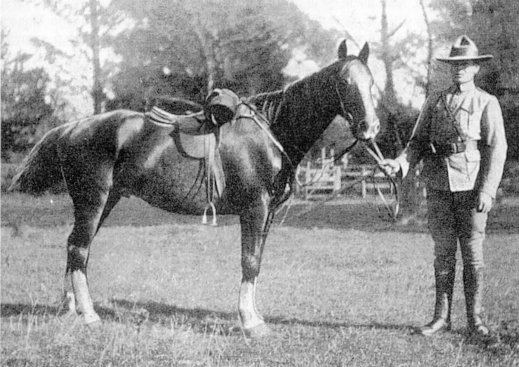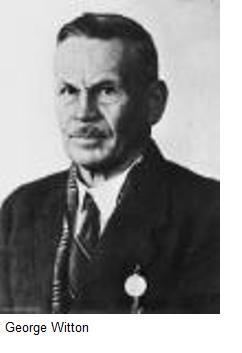Name George Witton | ||
 | ||
Books Scapegoats of the empire | ||
George Ramsdale Witton (1874–1942) was a Lieutenant in the Bushveldt Carbineers in the Boer War in South Africa.
Contents
- Early life and involvement in the Boer War
- Scapegoats of the Empire book and later life
- 2009 petitions for review of court martial
- References

He was temporarily sentenced to death for murder after the shooting of nine Boer prisoners. He was subsequently reprieved by Kitchener, although Lieutenants Peter Handcock and Harry "Breaker" Morant who had been court martialed with him were executed by a firing squad on 27 February 1902.

Early life and involvement in the Boer War
Witton was born near Warrnambool, Victoria, Australia, and was from a farming family; prior to his VIB enlistment, he was a gunner in the Royal Australian Artillery. He enlisted in the Victorian Imperial Bushmen for the Boer War, and was promoted from Corporal to Squadron Quartermaster-Sergeant. Major Robert Lenehan enlisted him in the Bushveldt Carbineers with a commission as Lieutenant.
After the killing of a number of Boer prisoners, Witton was one of four officers charged by the British Army with murder, and was convicted. However, he strongly protested and secured a legal opinion from Isaac Isaacs KC, an Australian member of parliament, who recommended that he should petition HM the King for a pardon. Kitchener commuted Witton's sentence to life imprisonment. After further protests, he was released on 11 August 1904, although not pardoned. He had been ill twice in prison in England, once from arsenic fumes in a metal shop and once from typhoid fever. He returned to Australia on 12 November 1904 embittered after three years in prison and wrote a book giving his version of the events involving Morant, Handcock and the BVC.
Scapegoats of the Empire book and later life
His book, Scapegoats of the Empire was originally published in 1907 by D. W. Paterson of Melbourne, but was long unavailable. Prior to its reprint in 1982 by the Australian publishing house Angus & Robertson, it is claimed that only seven copies of the book survived in various Australian state libraries and in the possession of Witton's family. Although unsubstantiated, it has long been claimed that the book was suppressed by the Australian government and most copies were destroyed; another explanation is that most of the copies were destroyed by an accidental fire at the publisher's warehouse. The 1982 reprinting was inspired by the success of a film based on the book, entitled Breaker Morant. George Witton's cousin, Cecily Adams of Castlecrag Sydney, owned the copyright for "Scapegoats of the Empire" following George's death. Cecily was also aware of some additional documentation written by George Witton, which he asked not to be released until after his death. Cecily was determined a further edition, which included this additional material, should be published and in 1989 an edition was published by ADLIB BOOKS of Bath, by arrangement with Cecily Adams as the copyright owner and Angus & Robertson (UK).
Witton's main assertion, as indicated by the book's provocative title, is that he, Morant, and Handcock were made scapegoats by the British authorities in South Africa — that they were made to take the blame for widespread British war crimes against the Boers, and that the trial and executions were carried out by the British for political reasons, partly to cover up a controversial and secret "no prisoners" policy promulgated by Lord Kitchener, and partly to appease the Boer government over the killing of Boer prisoners, in order to facilitate a peace treaty; the Treaty of Vereeniging was signed on 31 May 1902.
Witton also claims that many of the accusations about them, which led to their arrest and trial, were made by disaffected members of their regiment whose rebellious behaviour had been suppressed by Morant and Handcock.
An embittered Witton did not rush to enlist in World War I. After former and future Prime Minister Andrew Fisher pledged during the 1914 general election that Australia would defend Britain "to the last man and last shilling," Witton intimated that he would be that last man. He lived in Gippsland, Victoria and in Queensland where he was a dairy farmer. He married twice, but did not have any children. He had a heart attack while cranking his car engine, and died in a hospital on 14 August 1942. He was buried in Brisbane's Lutwyche Cemetery which, coincidentally, is located on the corner of Gympie and Kitchener Roads.
2009 petitions for review of court martial
In 2009, an Australian lawyer and naval reservist, Commander Jim Unkles, submitted personal petitions, requesting a review of the convictions for Morant, Handcock and Witton, to the The Crown, in the form of:
The petitions committee considered Unkles' petition on 15 March 2010. He appeared before it, along with others including historian Craig Wilcox. Committee member Alex Hawke MHR stated: "there is in my view serious and compelling evidence that some form of redress should be given, all these years later, to those men executed by the British". The then Attorney-General of Australia, Robert McLelland referred the petition to the UK government.
On behalf of the Crown, Unkles' petition was rejected by UK Defence Secretary Liam Fox, in November 2010.
